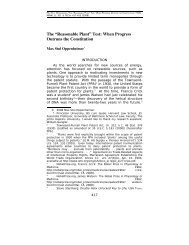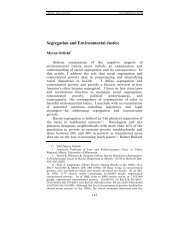An Organizational Approach to the Design of Patent Law
An Organizational Approach to the Design of Patent Law
An Organizational Approach to the Design of Patent Law
You also want an ePaper? Increase the reach of your titles
YUMPU automatically turns print PDFs into web optimized ePapers that Google loves.
6 VERTINSKY FINAL_JAD (DO NOT DELETE) 2/27/2012 2:20 PM<br />
2012] AN ORGANIZATIONAL APPROACH 221<br />
A. MAINSTREAM THEORIES OF PATENTS<br />
The dominant <strong>the</strong>ory underlying much <strong>of</strong> <strong>to</strong>day’s patent<br />
law and policy is <strong>the</strong> “reward <strong>the</strong>ory” <strong>of</strong> patenting. 33 At its most<br />
basic, this <strong>the</strong>ory explains that patents provide necessary incentives<br />
for invention by allowing inven<strong>to</strong>rs <strong>to</strong> appropriate <strong>the</strong><br />
returns from <strong>the</strong>ir efforts at <strong>the</strong> cost <strong>of</strong> restricting use <strong>of</strong> <strong>the</strong> resulting<br />
inventions. 34 The “reward <strong>the</strong>ory” is supplemented by<br />
<strong>the</strong> “disclosure <strong>the</strong>ory” <strong>of</strong> patenting, which suggests that by<br />
providing property rights in discoveries <strong>to</strong> inven<strong>to</strong>rs, patents<br />
will allow inven<strong>to</strong>rs <strong>to</strong> disclose <strong>the</strong>ir information without fear<br />
that <strong>the</strong> benefits <strong>of</strong> <strong>the</strong> information will be appropriated. 35<br />
Recognizing <strong>the</strong> importance <strong>of</strong> downstream investments in<br />
exploiting new inventions, a second main branch <strong>of</strong> <strong>the</strong>ories<br />
has focused on <strong>the</strong> functions <strong>of</strong> patents in providing incentives<br />
for <strong>the</strong> development and commercialization <strong>of</strong> inventions. This<br />
branch includes Edmund W. Kitch’s well known “prospect <strong>the</strong>ory,”<br />
which examines <strong>the</strong> role <strong>of</strong> broad, strong patent property<br />
rights in ensuring efficient investment in and management <strong>of</strong><br />
downstream innovation. 36 O<strong>the</strong>r approaches focus more specifically<br />
on <strong>the</strong> need <strong>to</strong> induce <strong>the</strong> development and commercialization<br />
<strong>of</strong> early stage inventions where much <strong>of</strong> <strong>the</strong> investment<br />
and problems <strong>of</strong> appropriability occur after <strong>the</strong> initial discovery<br />
has taken place and are undertaken by different organizations.<br />
37<br />
These mainstream <strong>the</strong>ories <strong>of</strong> patents diverge in <strong>the</strong>ir concern<br />
for upstream investment versus downstream development<br />
<strong>of</strong> <strong>the</strong> invention, and in <strong>the</strong> types <strong>of</strong> market failure that justify<br />
<strong>the</strong> need for patent rights. But <strong>the</strong>y share a similar starting<br />
33. Kieff, supra note 9, at 398–406.<br />
34. Without patents—or so <strong>the</strong> incentive <strong>the</strong>ory <strong>of</strong> patents goes—ei<strong>the</strong>r<br />
<strong>the</strong> invention would be kept as a trade secret, limiting access <strong>to</strong> <strong>the</strong> idea, or<br />
o<strong>the</strong>rs would be able <strong>to</strong> freely copy and use <strong>the</strong> inventions at lower cost, resulting<br />
in an under-supply <strong>of</strong> inventions and follow on innovation.<br />
35. According <strong>to</strong> Kieff, conventional views <strong>of</strong> patents are largely based on<br />
three dominant incentive <strong>the</strong>ories <strong>of</strong> IP: (1) some version <strong>of</strong> <strong>the</strong> “incentive <strong>to</strong><br />
invent” and “disclose” <strong>the</strong>ories treated <strong>to</strong>ge<strong>the</strong>r under <strong>the</strong> rubric <strong>of</strong> “reward,”<br />
(2) <strong>the</strong> “prospect” <strong>the</strong>ory; and (3) <strong>the</strong> commercialization <strong>the</strong>ory. Kieff, supra<br />
note 9, at 398–406; see also Rebecca Eisenberg, <strong>Patent</strong>s and <strong>the</strong> Progress <strong>of</strong><br />
Science, 56 U. CHI. L. REV. 1017, 1024–28 (1989) (discussing alternative <strong>the</strong>ories).<br />
36. For fur<strong>the</strong>r explanation <strong>of</strong> <strong>the</strong> prospect <strong>the</strong>ory, see Edmund Kitch, The<br />
Nature and Function <strong>of</strong> <strong>the</strong> <strong>Patent</strong> System, 20 J.L. & ECON. 265 (1977). According<br />
<strong>to</strong> prospect <strong>the</strong>ory, strong patent rights protect <strong>the</strong> incentives <strong>of</strong> <strong>the</strong><br />
invention owner <strong>to</strong> make investments that maximize <strong>the</strong> value <strong>of</strong> <strong>the</strong> patent.<br />
37. Mazzoleni & Nelson, supra note 23, at 1040.






